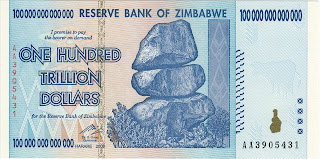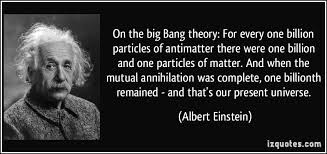
Alrighty then. If the Higgs turned out to be what we thought it should be, then the universe should have ripped itself apart. We were off by 10**17, which is 100 quadrillion times smaller than we thought it should be. Not only is the Higgs exactly what it needs to be for us to be here, even the universe wouldn't be here if it were different.
That's a big mistake. Biiiig. Huuuuge. Like, you got your first paycheck, and instead of it being $1 (which would be deeply disappointing for a paycheck), it was $100,000,000,000,000,000. Only the other way around. Which would not be disappointing at all.
 |
| You'd need 1000 of these. If they were worth anything. |
But that's not the biggest mistake we ever made in physics.
The biggest mistake was what we thought the Cosmological Constant ought to be.
What, you just said out loud, the heck is the Cosmological Constant?
I'm sure you said "heck". This is a family science blog. That occasionally says things like "crapload".
Anyway.
I'm so glad you asked what the Cosmological Constant is. There's a good story.
So. Albert Einstein came up with the General Theory of Relativity. It was awesome. And it was always right.
Then this Belgian guy who was not only a brilliant physicist but a
priest (seriously!?) was working through the math one day and discovered something. His name was Georges Lemaitre. You should pronounce that in the French way. I'll help. It's pronounced "baguette". You're welcome.
He discovered that the math of the General Theory predicted, all by itself, with no evidence at all to support it, that the universe was not infinitely large or old but actually had a starting point.
And the General Theory was always right.
This was upsetting.
Everyone was busily assuming that the universe was infinite in size and age, that it had always been here.
But it hadn't.
Albert didn't like that at all. So he figured that he needed to fix it, because everybody (I mean, everybody) knew that the universe didn't have a starting point. Except religious people. And you know how they are.
So he tried to fix it. He stuck this number in his beautiful, gorgeous equation to try to force the universe to be infinite. And the number was called (drum roll) ...
The Cosmological Constant. He gave it a Greek letter, lambda (∧), and just kinda stuck it in there.
It was ugly. Here's what it should look like:
Much better.
He left it there for awhile. Hoping.
And then Edwin Hubble (who invented hubble gum)(I may have
made that up)(there's no such thing as hubble gum) discovered that the universe actually was expanding, and therefore was not infinite. That it had a starting point. He found the physical evidence that this was true.
Space-Time (you remember Space-Time?) was stretching as time went forwards, so if we look backwards in time, Space-Time is doing the opposite of stretching. Unstretching. Contracting. Getting smaller. So small that eventually all of Space-Time just ... goes away. So then, if you start right there at the beginning, the universe just ... arrives.
 |
| Space-Time stretching. OK, Plastic Man. But he's made of Space-Time, so it works. |
Later on, Fred Hoyle called this "the Big Bang", 'cause he thought it was a dumb idea.
But it wasn't.
So Albert had to take the Cosmological Constant out of the General Theory. It was a bit embarrassing. He had to apologize to Lemaitre. In French, no less. For a German, that really hurts.
That was, like, 1929.
Time passes. Einstein dies. Hubble dies. Lemaitre dies. Not necessarily in that order. Nobody pays very much attention to the Cosmological Constant. It was a bad idea. Very bad. Totally wrong.
Hah! is what the universe says about that.
Then in 1998 (almost 70 years later), some guys discovered that the universe was expanding a lot faster than we thought.
Huh, they said. What would make that happen?, they wondered. So they said to themselves, in order for the universe to start expanding faster than it was, that would take something that looks a lot like ... energy. Like, the opposite of gravity. Gravity draws things together. This is things getting pushed apart. And that would take some sort of energy.
Huh, they said. Why can't we see it? What the heck is it? Where the heck is it?
So they won the Nobel Prize. But they still don't know what it is.
So they called it ... Dark Energy. Which means, we don't know
what it is or where it is or how it works, but it kinda seems like it's got to be energy, but we can't see it or measure it or touch or anything.
So we'll call it Dark Energy. "Invisible, Undetectable, Immeasurable Energy" would have been better, but Dark is like, a cool word. They say that Dark Energy might be the energy that empty space has.
Huh?
So empty space now has invisible energy in it?
Very strange.
And guess what they decided to use? Einstein's Cosmological Constant.
And they figured out what the value would have to be. And they wrote it down.
And they were so, so, so wrong.
The number they predicted is a trillion trillion trillion trillion
trillion trillion trillion trillion trillion trillion times bigger than the actual value. That's 10**120 bigger.
And if the Cosmological Constant was any bigger than it is, the universe would be ripped apart. Again.
That's the biggest mistake in the history of mistakes. Here's how big that is:
There are about 10**120 elementary particles in the entire observable universe. Plus or minus. We were wrong by the number of particles in the universe. That's a crapload of wrong, is what that is. It's a thousand trillion trillion trillion times bigger than the number of atoms in the Universe.
So here's what we've got. If either the Higgs Boson or the Cosmological Constant were what we thought they should be, the universe would have blown apart before it ever got started.
They have to be just what they are. Or we wouldn't be here.
They've been called "The Two Most Dangerous Numbers in the Universe." Here's a link for you to go read.
http://www.sciencealert.com/the-2-most-dangerous-numbers-in-the-universe-could-signal-the-end-of-physics
Here's a quote:
"At the core of Cliff’s argument are what he calls the two most dangerous numbers in the Universe. These numbers are responsible for all the matter, structure, and life that we witness across the cosmos. And if these two numbers were even slightly different, says Cliff, the Universe would be an empty, lifeless place."
And it's the Higgs Interaction, of course. And the expansion rate of the universe is an interaction between Dark Energy and Space-Time. Because all there is, is interactions.
Gotta have the Higgs. Gotta have Dark Energy.
Next. Gotta have Dark Matter.










































